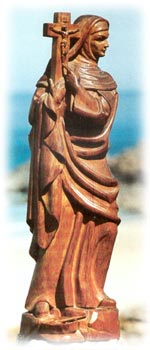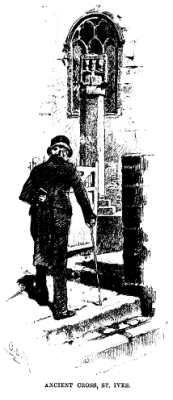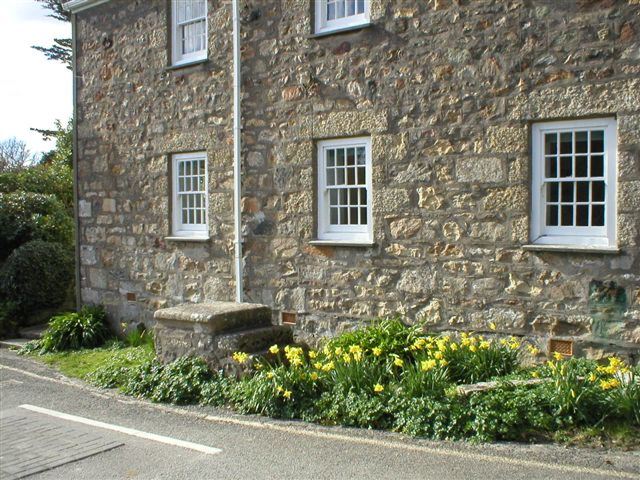
Lelant to St Ives
by Sandra Pritchard
The
first mention of an inn in Lelant was in 1284 when Michael the Gascon was
the owner of taverna. Intriguingly the vicar of St Euny, Lelant a few years before was one Sir Walter, called Gascoyn, in office as vicar but one
before Sir Amand de Cambron instituted on 20 Nov 1281.
Some
of Michael’s customers got drunk, fell out had a fight and murder was the
result. According to Matthews in his “History of Lelant, St Ives and
Towednack” pub. 1892:.
inn where persons coming
to divine service from a distance could
stable their horse and
find refreshment. At the door of the stables
is an old mounting
block"

This must have been the
original village inn of the village, as they were often built beside the church on church land.
They were first used as accommodation and refreshment house for the church
builders and later served the same purpose for the congregation and visiting
pilgrims on their way west to St Michaels Mount. The murder story begins with
getting drunk, possibly in this Lelant inn.
The record of 1284 is brief but Richard and Odo -who were brothers - and Elger, had been drinking at Michael the Gascon's inn in Lelant, then not much more than a collection of dwellings around the church. The three left the inn and made their way up to the crossroads, on past Trevethoe and up the hill towards Cripples Ease until finally they reached the Ludgvan road. However, at some point on their way home their drunken frivolity gave way to quarrelling and Elger stabbed Richard in the stomach with a knife. The actual murder took place in the "tithing" of Ludgvan in the next parish.
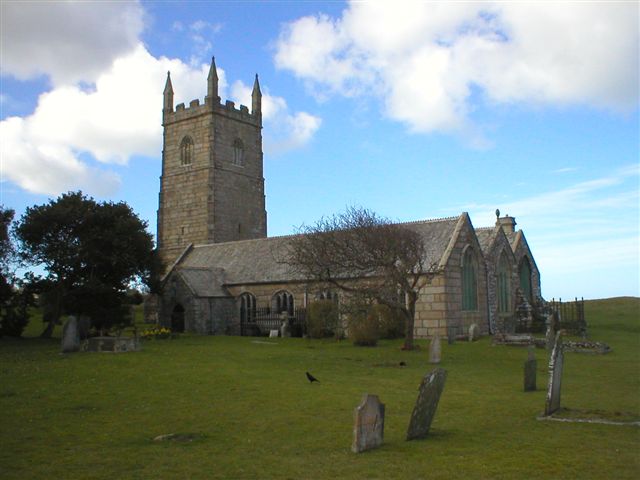
Poor Richard took two days to
die, a slow agonising death. Elger, after stabbing him, had fled back to the
sanctuary of Lelant church, where he was safe, since sanctuary from the law was
then given. The record of the events that followed was recorded at an Assize in
Launceston sometime after the actual event. Although the judges met at Easter
time in 1284 the murder may have taken place many years before. The previous
Assize had been in 1269 so all we can say with certainty is that Elger murdered
Richard sometime between 1269-1284
The judges looked at what had
happened on the road between Lelant and Ludgvan and how the authorities had
dealt with it. Crime and punishment was the ultimate responsibility of the
community elders. They had the duty of pursuing and catching the criminal and
bringing him to trial and were fined if they failed or got it wrong. A
“tithing” was a unit of authority and administration before the
establishment of the parish system. These were harsh and brutal times. According
to the Cornish historian Henderson, William the Conqueror had advocated that,
“No one shall be hanged or killed for any crime, but put out his eyes or
castrate him”
Elger the murderer did not
die for his crime or even suffer one of the “lesser “ punishments as he had
gained sanctuary and chose abjuration of the realm; in other words, permanent
exile. He confessed his crime before one John le Petit, as coroner, and a jury
from among the assembled villagers. They heard him swear an oath to leave the
country forever. He forfeited all his belongings and wearing sackcloth and ashes
he travelled to a port appointed by them and caught the first available boat to
anywhere. He could only return to England if pardoned by the king.
A record of these proceedings was produced for the Assize judges when they came to Launceston in 1284. They were to judge and review how the coroner and jury had dealt with it. They were not so much about ensuring that justice was done but more about fining anyone and everybody for failing to follow the rules exactly, thus filling the king’s coffers. The judges looked at the report presented and found that the jury had not concluded whether Odo, present at the murder, was guilty of any crime. His exact part in the quarrel and fight is unknown. They also found that Elger's goods were undervalued and as a result the jury were fined, which the whole village would pay through their regular rates. Having got money from the villagers, the judges then turned to the coroner. As he had failed to mention Odo in his record, he too was fined. They also decided that because the murderer had fled from Ludgvan through the nearby “tithings” of Treeve and Drannack, who had all failed to apprehend the murderer and who had not come to the inquest, they too were all fined. All in the king did very well out of Richard's murder.
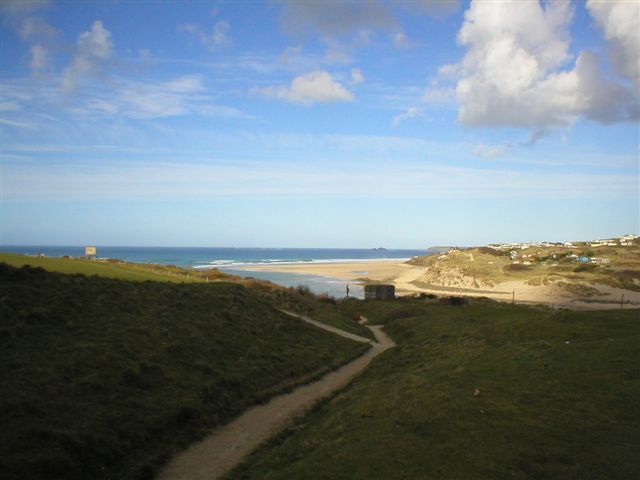
Today we can walk past the inn and church and along the sand dunes to return to St Ives, just as many did before there was a church built in the little fishing village in the 1400's. Then the walk would take you past little scattered farmsteads and not much else. Streams ran down from the hills above Trencrom spilling on to the beaches of Lelant, Porthkidney, Carrack Gladden, Porthrepta, and Porthminster, with the settlements of Charlestown, Chyangweal, Gunwin and Longstone scattered over the downs.
Passing the headland of Hawke’s Point we must note that time has given this place a variety of names. Once it was known as 'Crinks Point', commemorating a theatrical impresario who had at first had a tent which travelled about the countryside with a company of actors. He eventually set up a semi-permanent theatre on the sands at St Ives. He was patronised by the local miners and also by curious children, who would burrow through the sand under the canvas flaps for a sight of the 'goings on'. A young man by the name of Johnny Broadribb must have caught a glimpse of a performance and became enchanted with the theatrical world. What his strict Methodist Aunt made of this attraction we do not know but he went on to become one of the most respected actors on the London stage, Sir Henry Irving.
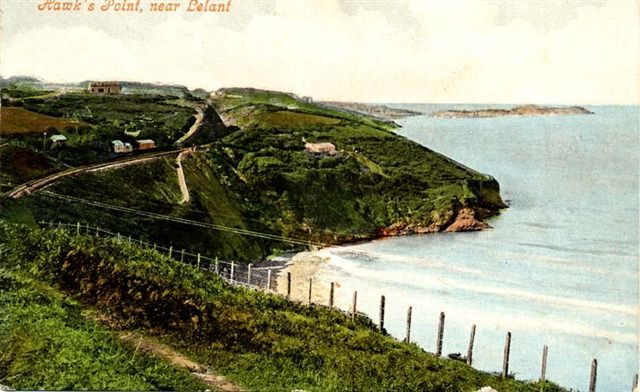
Hawke's Point from above Porth Kidney Beach
The Mr Crinks in question eventually gave up the theatre and went to live at Longstone, near Carbis Bay village, He acquired a little donkey shay and used to load it up with ginger beer, oranges and other refreshments which he sold to the handful of visitors at the entrance to Carbis Bay station. Often there were few visitors and he would walk to the point and sit in the sun dreaming of the far off theatrical days, reciting passages from Hamlet or Sweeny Todd. Perhaps he took delight in that he had 'helped' Irving on the road to his successful career. So the point became Crinks Point for a while.
Earlier a Mr Hawke had been a smallholder here and he used to collect any flotsam and jetsam off the beach after a gale. He used the old miner's steps cut into the cliff on the south side of the point. These led down to Porth Kidney beach originally 'Porth Kinnis' which meant 'firewood' beach, so he was not the first 'wrecker' to comb the beach. Perhaps the last to use these steps for that purpose was a character called Shanghai" He was supposed to have accrued a small fortune and the steps then acquired the name of "Shanghai's Golden Stairway".
Before the railway cut the headland in half the point was very picturesque, despite the diggings of the miners who worked there. The mine had earlier been named Hawke's Point mine but by 1861 had been renamed Wheal Fanny Adela. This was the name of the young lady who was to marry William B Tyringham, the heir to Trevethoe Estate, at Lelant in 1865. It was a very small mine. The managers were Joseph Vivian & Sons of Camborne and the agent a Mr. H Stevens. The purser was A.H.D. Vivian, probably from the same Camborne family and the engineer was a W Bennett, plus just five workmen. The shaft was some 25 fathoms deep [150ft]. As well as tin, copper & lead it produced small quantities of cobalt and nickel-silver but by 1871 it was "knacked" and a few years later the building of the track from St Erth to St Ives had begun.
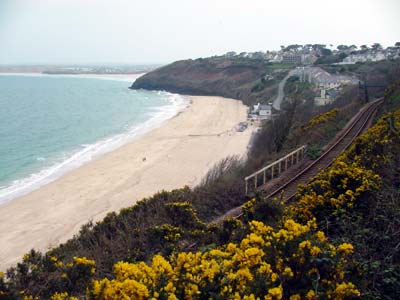
Carbis Bay towards Hawke's point, Hayle Towans in the distance
J. Glasson first moved with his parents to Gonwin Farm in1859.As a child of nine he had worked on the dressing floors of Wheal Providence; ten hours a day for wages of eight shillings a month. He emigrated to the mines in Kadina, Australia and in old age he cast his mind back to the scenes of his youth and in particular to his beloved Hawke's Point.
"In the seclusion of hazel bush and wild briar, a rich little three-cornered meadow of beautiful potato and vegetable soil led down to the very edge of the cliff, just where it turned north towards the headland. Here was a well of water, somewhat similar to the Holy well of St Uny, but far more secluded and silent, being so enshrouded in the shadows of the overhanging ferns and foliage, of hazel and briar bushes, that it was scarcely known and seldom visited. So secluded was this precious little nook overlooking the beach and Bay, that only in the early morning could the sun ever get a peep at it. Here the maidenhair fern developed as in no other place along the cliff."
Then, a singular man by the name of William Bottrell was living at Hawke's Point in a tumble-down old cottage. After many hardships and heart aches, he had chosen to live out the remainder of his life as a recluse, collecting ancient Cornish customs and folk tales. The youngsters looked on him as " a gentle old man and always kind to the children who came to him for fruit and vegetables, for which his orchard and garden were famed"
Later a friend was to write of him:-
Here he lived in a hovel and cultivated a little moorland, He had a black cat called ‘Spriggans’ plus a cow and pony. These animals would all follow him down the almost perpendicular cliff, over a goats path, to the spring which was their water supply and no accidents happened to either.”
He went on to tell how Bottrell became a friend of the Tinners who worked in the near-by mines.
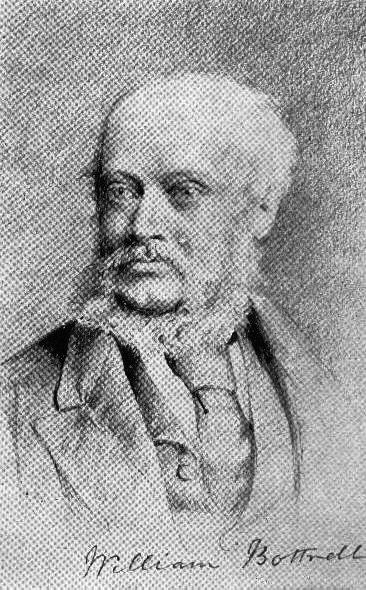 ." They
would do a days work underground then think nothing of spending a couple of
hours helping Bottrell clear ground in order that he could create a garden. It
was from these men that Bottrell learned more of the ancient tales of West
Cornwall. As they sat by the fire in the cottage which he had made his home, one
of their number would tell a tale whilst William drew a sketch of the man and
made notes on the narrative. Bottrell always acknowledged the debt he owed to
these men; he said of them 'they have intelligence, mother-wit and memories and
I am able to garner
from the ample harvest.' ”
." They
would do a days work underground then think nothing of spending a couple of
hours helping Bottrell clear ground in order that he could create a garden. It
was from these men that Bottrell learned more of the ancient tales of West
Cornwall. As they sat by the fire in the cottage which he had made his home, one
of their number would tell a tale whilst William drew a sketch of the man and
made notes on the narrative. Bottrell always acknowledged the debt he owed to
these men; he said of them 'they have intelligence, mother-wit and memories and
I am able to garner
from the ample harvest.' ”
William Bottrell first appeared in print in the columns of The Cornish Telegraph of 1867, where he gave an account of “The Penzance of our Grandfathers.” Under the pseudonym “Old Celt”. Many articles appeared subsequently in this paper and in “One and All” magazine. Of all these various articles the best were gathered together and published in three volumes. Life began to improve for William and he moved into a relative's house in St Ives town. Before the completion of his last volume he suffered a stroke & was severely paralysed. After six weeks of suffering he died at his home in Dove Street ,St Ives at 10am on 27 August 1881. He was taken back to his old home village of Raftra above the cliffs near Land’s End and he was buried in the churchyard he loved the most, on the cliffs above St. Levan's Holy Well.
His obituary included the following anonymous poem in remembrance of the sad loss of such a literary treasure, his words now silent forever.
“A
sun-dial pillar left alone,
On which no dial meets the eye;
A black mill-wheel with grass o’ergrown,
That hears no water trickle by:
Dark, palsied mass of severed rock,
Deaf, blind and sear to sun and rain;
A shatter’d gravestone’s time worn block
That only shows an honoured name.”
I am proud to claim William
Bottrell as a branch of my family tree.
The young miner Glasson left his beloved St Ives and did not return for nearly 40 years. He re-visited the places of his youth in1915 and found all the fairy spirits gone and the old familiar landscape vanished. The railway had cut through the most beautiful part of the foliage-covered cliff and the well, sanctuary of the ancient Gods of Cornwall, was no more. Instead, a great wall had been built to stop the railway falling over the edge of the cliff. The beautiful little meadow, with its swing gate leading out to the nut grove, was now buried under the railway cutting rubble and nothing remained, save in his memory. Sadly the little nut grove and ancient well and headland were much destroyed by the coming of the railway in 1874 but the footpath walk is still a favourite with visitor and visiting exile alike.
A little way further along, after passing the beach at Carbis Bay, the view just after passing the huer's hut is breathtaking; St Ives stretches out before you, a pearl set in a silver sea. The land around here was given by the Hain family, [of which more later] when other landlords made attempts to prevent trespassers on their land. As the ancient huer's huts and look-out were vital to the survival of the fishery, Edward Hain acted with commendable altruism. At one time the seine boat fleet was drawn up for the winter on the sands below, in the end competing with both the railway and the tourists for space. Alas the latter won and the last of the seine boats were left to rot away on the beach in the 1920's

Wilkie Collins in his book "Rambles Beyond Railways" in 1851 attempted to describe the method and manner of seining and tucking pilchards. He begins by describing how a stranger to Cornwall might at first view the actions of the huer.
He
would see a man standing on the extreme edge of a precipice, just over the sea,
gesticulating
Once, somewhere in the wooded
valley below which stretched up to the heights above Tregenna, was a village by
the side of a stream. This was the ancient settlement of Minster [locally pronounced
'Mester] perhaps so called because it had a small Chapel or Minster for the holy
man. This was probably located somewhere near the stream as once, after a great
storm, much of the sand was washed away from the beach and large
worked stones were discovered near the outflow. The little building's existence
is now only remembered in the name of the wide, white sandy beach - Porth
Minster.
People standing a little way back from the shoreline on the track way that runs towards the valley have frequently reported seeing figures come ashore here at dusk They appear from around the headland and, after hauling their boat out of the water, they kneel on the sand in a circle They are dressed in dark cowls and cloaks and all are bearded. After a few minutes they are seen to start climbing the cliff and then suddenly disappear.
This sighting has had numerous witnesses over the years but as recently as 1976 the second chapter in the story evolved. Some people further up the cliff, sitting on the bench seat just below the coastguard houses, were watching the sun go down behind the island when their reverie was interrupted by a column of men ascending from the beach below. As soon as they reached a piece of level ground they turned right, making tracks higher up the valley, towards what is now the entrance to the grounds of Tregenna Castle. The gathering dusk soon took them out of sight. Comparing the two accounts revealed that the habits of the second apparition were like those of monks and their position on the path indicated that they appeared to be a continuation of the first group. All this took place in silence with no words spoken, nor clanking of swords heard, as darkness fell.
Perhaps this was the site of the original St Ia’s holy cell when she safely landed after drifting across from Ireland on a leaf. At some time in its history there was an invasion from the sea and the original little settlement was burned to the ground but before the railway came there was still a scattering of cottages in the Primrose Valley at the back of the beach. Later Draycott Terrace was built together with the Coastguard Station and Porthminster Hotel but echoes of the past may continue to vibrate on a still and pleasant evening.
.